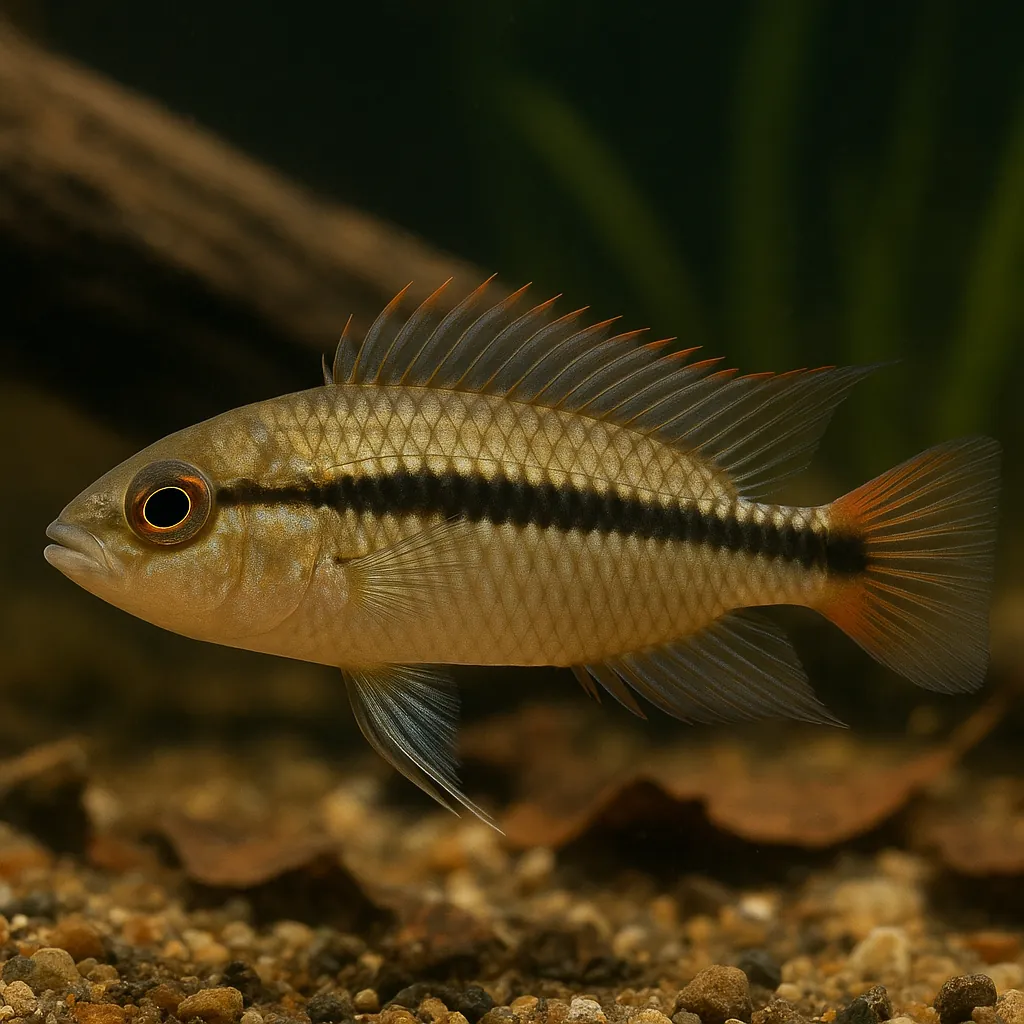
Blackstripe dwarf cichlid
Introduction
The Blackstripe dwarf cichlid, scientifically known as Apistogramma bitaeniata, is a captivating freshwater fish cherished by aquarists for its vibrant colors and intriguing behaviors. Native to the Amazon River basin, this species is particularly noted for the two distinct horizontal stripes running along its body, giving rise to its common name. While their care requires attention to specific water parameters and tank conditions, they are a rewarding choice for hobbyists seeking to delve into the world of dwarf cichlids.
What makes the Blackstripe dwarf cichlid appealing to aquarists?
Its striking coloration, unique markings, and engaging behaviors make it a standout addition to freshwater aquariums.
Is this species suitable for beginner fishkeepers?
Due to its specific care requirements, it's better suited for aquarists with some experience in maintaining stable water conditions and managing territorial fish.
Care and Environment
Proper care for the Blackstripe dwarf cichlid involves replicating its natural habitat to ensure health and vitality. A minimum tank size of 60 liters is recommended for a single pair, with larger volumes needed for groups. The tank should be equipped with a soft, sandy substrate and decorated with driftwood, caves, and leaf litter to provide ample hiding spots and mimic their natural environment. Incorporating live plants like Microsorum, Taxiphyllum, Cryptocoryne, and Anubias can enhance the setup, offering additional cover and maintaining water quality.
Water parameters are crucial for this species. They thrive in soft, acidic water with a pH range of 4.5 to 6.5 and temperatures between 23°C and 26°C. Water hardness should be kept low, ideally between 2 to 6 dGH. Regular monitoring and maintenance are essential to keep these parameters stable.
Filtration should be efficient yet gentle, as strong currents can stress the fish. A filter with a flow rate of 4-5 times the tank volume per hour is suitable. Dim lighting is preferred, which can be achieved by using floating plants to diffuse light.
Feeding should consist of a varied diet to meet their nutritional needs. They are primarily carnivorous, feeding on small invertebrates in the wild. In captivity, they accept live and frozen foods such as Artemia, Daphnia, and bloodworms. High-quality pellets or flakes can be offered, but live or frozen foods should form the bulk of their diet.
One challenge in keeping Blackstripe dwarf cichlids is their sensitivity to water quality and changes. They are also territorial, especially during breeding, which can lead to aggression. Providing sufficient hiding spots and monitoring tank dynamics can help mitigate these issues.
What is the ideal tank setup for a pair of Blackstripe dwarf cichlids?
A 60-liter tank with a soft, sandy substrate, ample hiding spots like caves and driftwood, live plants, and dim lighting to replicate their natural habitat.
How can I maintain the appropriate water parameters for this species?
Regular testing and maintenance, including partial water changes and the use of peat or leaf litter, can help maintain soft, acidic water conditions.
What should I feed my Blackstripe dwarf cichlids?
A varied diet of live and frozen foods like Artemia and Daphnia, supplemented with high-quality pellets or flakes.
Origin and Habitat
The Blackstripe dwarf cichlid is indigenous to the Amazon River basin, specifically found in black-water river systems in Peru and adjacent regions of Brazil. They inhabit slow-moving tributaries, backwaters, and creeks where the substrate is often covered with fallen leaves and organic debris. These environments are characterized by soft, acidic water with low mineral content and a rich presence of tannins, giving the water a dark, tea-like appearance.
Where can Blackstripe dwarf cichlids be found in the wild?
They are native to the Amazon River basin, particularly in black-water systems in Peru and Brazil.
What type of environment do they prefer?
They thrive in slow-moving waters with soft, acidic conditions and abundant leaf litter.
Temperament and Compatibility
Blackstripe dwarf cichlids exhibit territorial behavior, especially during breeding seasons. Males establish territories and may display aggression towards other males. However, they can coexist with other peaceful, similarly sized fish if the tank is spacious and well-structured. Suitable tank mates include small tetras and pencilfish, which occupy different areas of the tank and are less likely to provoke aggression.
It's advisable to avoid housing them with larger or more aggressive species that might intimidate or outcompete them. Providing ample hiding spots and visual barriers can help reduce stress and territorial disputes.
Are Blackstripe dwarf cichlids aggressive?
They can be territorial, especially during breeding, but with proper tank setup and compatible tank mates, aggression can be minimized.
What are suitable tank mates for this species?
Peaceful, small fish like tetras and pencilfish that occupy different tank areas are ideal companions.
Interesting Facts
One fascinating aspect of the Blackstripe dwarf cichlid is its breeding behavior. They are cave spawners, with females laying 40-60 eggs on the ceilings of caves. The female guards the eggs and fry, while the male defends the territory.
Another interesting trait is their color variation based on geographic location. Specimens from Brazil often display more yellow and red hues, while those from Peru tend to have a bluish coloration.
How do Blackstripe dwarf cichlids reproduce?
They are cave spawners, with females laying eggs on cave ceilings and guarding the fry, while males defend the territory.
Do they exhibit color variations?
Yes, their coloration can vary geographically, with Brazilian specimens showing more yellow and red, and Peruvian ones displaying bluish hues.
Sources
All information in this article has been gathered from the following reputable sources:
Overview
Recommended Tank Size 26.4 Gallons (for groups of 6 or more) |
Minimum Group Size 2 |
Minimum Tank Volume 15.9 Gallons |
Maximum Adult Length 3 inches |
Average Adult Length 2.4 inches |
Shoaling (6+ required) No |
Preferred Water Type Soft, acidic freshwater |
Temperature Range (°C) 23-26 |
pH Range 4.5-6.5 |
Water Hardness (dGH) 2-6 |
Typical Lifespan (years) 5 years |